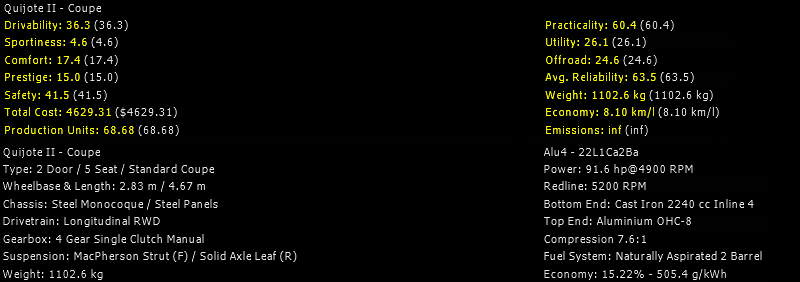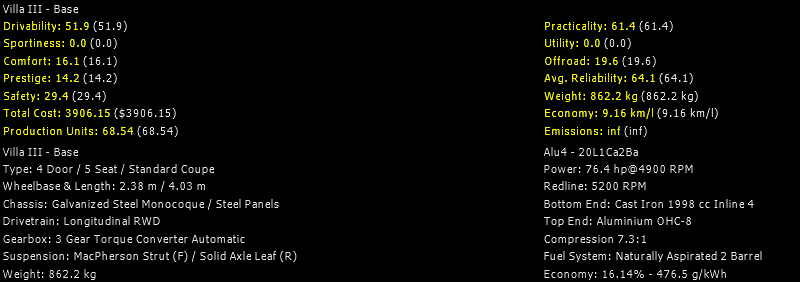@SeriousSimon Thanks, I’m glad to receive positive feedback for my models… but I don’t know how a mexican car should look  But I guess the influences of my childhood came up when I make my cars
But I guess the influences of my childhood came up when I make my cars 
1968 - 1972 Foxhunt [corporate]– 3 trims –[/corporate]
After the cancellation of the Madero, ADM was not ready to give up the sport market, dominated by the American car makers and (to some extend) by the national rival Meliora.
A few years earlier, a new project was in process, and finally in 1968 was presented the FoxHunt (the first car with a non-spanish name) named after the hound bred. Initially it was designed for racing in the American Trans-am racing, but due to lack of time and resources (it was meant as a mass produced car) at the end it didn’t participated.
3 Trims were offered, the L6 powered by a re-tuned variant of the 3.6L OHV inline 6 used in the Mastin trucks line-up, the V8 powered by the same engine as the Rivera GLX and finally the Grand Prix, which was the top of the line, using a more powerful 4.9L V8. All of them matted to classics 4 speed gearbox (a close-gear ratio in case of the Grand Prix).
Sadly, due to the lack of power, the Foxhunt is considered a Pony car and not a Muscle car, but that doesn’t diminish of what the car is capable. Thanks to its well engineer chassis (it was the first monocoque ADM car) and engine, it had a perfect weight distribution [tho it was a coincidence, since the ADM engineers are the less… experimented of all my companies] and it had a perfect sport handling, easy to control but capable of roll out the tail when you press the pedal too hard.
With a 7.4s time from 0-100 km/h, it was in the range and even faster than the
Ford Fairlane GTA 390 6.4 V8, the Ford Mustang Mach 1 351 and even the Chevrolet Camaro Z28 Sport Coupe from 1967, but a tad slower than the Dodge Dart and the Chevrolet Impala.
It was also faster than the '65 Meliora Leopardo Rally Sport (334hp) 7.5s and the '65 Kodiak Hornet 7.7s,
Foxhunt Grand Prix

1968 price: $2,799
Foxhunt V8

1968 price: $2,620
Foxhunt L6

1968 price: $2,400
If the Foxhunt looks very much like an HK-HG Monaro that’s because it practically is one, since it uses the HK coupe body from @Corvette6317, is available with a variety of OHV straight-sixes and V8s, and has a similar independent front/live axle rear suspension setup. However, I have built similar cars with this body using double wishbones at each corner, as well as a galvanized steel monocoque chassis for better environmental resistance, although they usually cost more, with the extra price being justified through the use of larger, more powerful engines and a premium interior. Then again, those cars, unlike the Foxhunt, compete in the Muscle class, not the Pony class…
And this company of yours is one of your best efforts, just like your other company. I would like to see how it evolves in the future.
@abg7 other than comparing my car to the Monaro (which by the way, other than the siluete of the car and maybe the air intakes it does not look like one), your post has nothing to do with my car, or the car company. You actually wrote about YOU and your amazing habilities designing cars. I don’t know if I should feel annoyed or upset, because going to someone else’s thread and just go like loudmouth is not cool.
Leave him. There’s always that type of person on the forum who always has something to say about everything even when he’s not welcome.
Quijote 2nd Gen
The second generation of the Quijote was presented at the end of 1958 and to be sold as a 1959 model. 2 trims were offered, the sedan and the coupé, this time there was no wagon (although the wagon of the last generation was still offered, since there were enough in stock).
This generation offered a less boxy body style and a more conservative design. It was based in a new platform, featuring a steel monocoque (the second for the company) with the old and reliable FR configuration with mcpherson struf front and a heavy duty solid axle in the back.
The more important part of the car was a brand new type of engine, called ALU4. It was a 4 cylinder engine, but this time with an aluminum block and iron head, with a Direct Acting overhead cam instead of pushroads. ADM was ready to move to more complex engine designs, and decided to begin with a small engine. Originally was designed to have an aluminum head and a iron block, but that prove to unreliable. Although the mix of iron and aluminum was too expensive to manufacture (and thus, ADM abandoned the idea for a couple of years), the use of DAOHC prove to be efficient and was adopted for future models.
OP updated with new line-up, flags for the current status of the models (in production, sold out, etc) and the current facilities.
1969 - 1972 Qujote Sedán

1969 price: $3,197

1969 price: $2,452
Very nice work. Genuine curiosity; why the much lower markup on the coupé? $600 is a lot for two more doors (I do prefer sedans). Were ADM trying to push sales of the coupe?
@stm316 Currently, the Coupé is aimed at the family sport demographic and the saloon to the family premium, and since the former has a highest budget I though I should squeeze them more money 
Right now, the entry level car is the Villa, and it is only available in a coupé, but for 1970 the new generation will be available in both sedan and coupe, filling that small gap.
The redesigned Qujote is a looker, and well-priced too… It’s going to be a brisk seller for sure. How will its replacement live up to its legacy?
Mastin Familiar (facelift) [corporate]–3 trims–[/corporate]
The last car of the 68-69 new lineup of ADM was the renewed Mastin familiar. 2 trims were
offered in the old platform and also a new special off-road edition, which was smaller and better equip for off roading, with a different grill.
The base was the entry level was equipped with just the basic, and the same engine as the Foxhunt L6, the Clase and the off-road were equipped with the same V8 as the Rivera Base, but as the offroad was in the interior basically the same as the base, the Clase was more like a Rivera SUV, with nice and comfortable seats with wood details and a phonograph.
1969 - 1972 Familiar Base

1969 price: $2,503
1969 - 1971 Familiar Clase

1969 price: $4,024
1969 - 1973 Familiar Offroad

1969 price: $2,617
Familiar Offroad looks like the same Familiar was produced for about 30 years and got facelifted in late 80s or early 90s 
1970 Villa 3rd Gen
By 1970 it was time to renew the old Villa, and a new generation was presented, incidentally, the last generation of the Villa. Designing wise, the car took some elements from the Familiar off-road, a japanese design and proven technology from the Quijote.
Carrying the now traditional FR setup with solid axle in the back, the car came only with a 3 speed automatic transmission powered by a de-stroked version of the ALU4 engine.
Also, it was the cheapest car ADM has ever sell, the price in 1970 was $1,680, a total bargain.
(market price: 8,640 w/20% markup)
1970 - 1974
Haven’t seen a car from you in a while! This is an excellent return 
Welcome back. The '70 Villa is a great family car by any measure - looks right, priced right and is right.
Loving the 70s brown you’re going for there
Dude very cool. You have to teach me how you do the engine graphs one day.
@phale @DeusExMackia @abg7 Thank! It was a long time indeed, but now I have a new job and I think I’ll be able to find more time to make more cars and stuff, I finally will be able to get closer to more modern times 
@Darkshine5 Whenever you want, it’s very easy once you do the first one 
1970-1974 Pilgrim
By the end of 1969, ADM took out of the market the Quijote Familiar their only wagon model, but in 1970 ADM presented the new Pilgrim, the second model with an non-spanish name.
Trying to move forward with technology, ADM developed a brand new V6 engine (they were to ditch out the L6 design, as it was too long and wasn’t very efficient) with Direct acting over head cams (as the Alu4) placed longitudinally pushing the front wheels. This design allowed the engineers to put most of the weight in the driving wheels and the engine was behind the front axle, giving a nice driving experience.
1970 price (w/19% markup): $2,058
1970 - 1972 NEWS: ADM CANCELS SUVs & PICK-UPS PRODUCTION
Due to the oil crisis, and internal problems inside the company, the production of the Mastin line is about to be cancelled. The pick-up models are already cancelled and the SUV versions will see the axe in 1971 (selling the stock through '72).
Old stakeholders of the company (the original ones from the time it sold agricultural equipment and it was called TCN) saw this with bad eyes, same as the new trend of naming cars in foreign languages instead of the traditional mexican last names.
1971 through 1972 was a hard time from the company, but the resolution was to split the company in 2 brands, one would retain the same name ADM and would sell mainly cars, with the new technology that has been developed by the company so far (DAOHC, V6s, monocoque and longitudinal FWD) and a second one called Mastin destined to produce big vehicules with some of the old tooling and technology (OHV V8, L6 and ladder chassis) as well as the Mastiff name rights.
The change was reflected in a new logo and the kill of the Quijote and Villa names. Only Rivera was kept, as it was the flagship of the company.
Old logo:

New logo:
Making Mastin a standalone brand makes perfect sense during the oil crisis - it would have been a millstone around ADM’s neck during such tense times. So how will you develop both brands from now on?






























